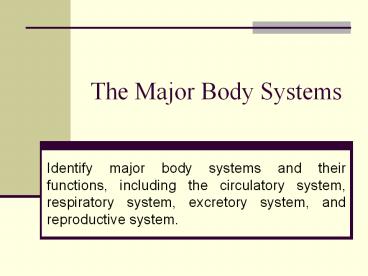The Major Body Systems - PowerPoint PPT Presentation
1 / 22
Title:
The Major Body Systems
Description:
The Major Body Systems Identify major body systems and their functions, including the circulatory system, respiratory system, excretory system, and reproductive system. – PowerPoint PPT presentation
Number of Views:81
Avg rating:3.0/5.0
Title: The Major Body Systems
1
The Major Body Systems
- Identify major body systems and their functions,
including the circulatory system, respiratory
system, excretory system, and reproductive system.
2
The Circulatory System
- The circulatory system is made up of the vessels
and the muscles that control the flow of the
blood around the body. This process is called
circulation. The main parts of the system are the
heart, arteries, capillaries, and veins.
3
- As blood begins to circulate, it leaves the
heart from the left ventricle and goes into the
aorta. The aorta is the largest artery in the
body. The blood leaving the aorta is full of
oxygen. This is important for the cells in the
brain and the body to do their work. The oxygen-
rich blood travels throughout the body in its
system of arteries.
4
- On its way back to the heart, the blood travels
through a system of veins. As it reaches the
lungs, the carbon dioxide (a waste product) is
removed from the blood and replace with fresh
oxygen that we have inhaled through the lungs.
5
What is Blood?
- Blood is thicker than water and has a slightly
salty taste. In an adults body there is 10.6
pints of blood circulating around. In their blood
there are billions of living blood cells floating
in a liquid called plasma. The red blood cells
are the heavier, more solid parts. The plasma is
lighter.
6
The Respiratory System
- The primary function of the respiratory system
is to supply the blood with oxygen to be
delivered to all parts of the body.
http//www.umm.edu/respiratory/images/respiratory_
anatomy.jpg
7
- Respiration is achieved through the mouth, nose,
trachea, lungs, and diaphragm. Oxygen enters the
respiratory system through the mouth and the
nose.
http//hes.ucfsd.org/gclaypo/repiratorysys.html
8
- The oxygen then passes through the larynx (where
speech sounds are produced) and the trachea which
is a tube that enters the chest cavity.
http//library.thinkquest.org/5777/resp1.htm
9
- In the chest cavity, the trachea splits into two
smaller tubes called the bronchi. Each bronchus
then divides again forming the bronchial tubes.
http//library.thinkquest.org/5777/resp4.htm
10
- The bronchial tubes lead directly into the lungs
where they divide into many smaller tubes which
connect to tiny sacs called alveoli.
http//library.thinkquest.org/5777/resp3.htm
11
- The diaphragm's job is to help pump the carbon
dioxide out of the lungs and pull the oxygen into
the lungs.
http//hes.ucfsd.org/gclaypo/repiratorysys.html
12
- There are many diseases that can harm and even
destroy the respiratory system. Asthma is an
increasingly common disease that causes coughing
and makes it hard to breathe. Lung cancer is a
major cause of death particularly among smokers.
Tuberculosis is a disease caused by bacteria that
can destroy the lungs.
13
The Excretory System
- The excretory system regulates the chemical
composition of body fluids by removing wastes and
retaining the proper amounts of water, salts, and
nutrients. Components of this system include the
kidneys, liver, lungs, and skin.
www.faqs.org/health/images/uchr_02_img0199.jpg
14
- The kidneys are organs that filter wastes (such
as urea) from the blood and excrete them, along
with water, as urine.
Cross section of a kidney
http//www.imcpl.org/kids/guides/health/excretorys
ystem.html
15
- The kidneys funnel the urine into the bladder
along two separate tubes called ureters.
http//library.thinkquest.org/5777/urin1.htm
16
- The bladder stores the urine until muscular
contractions force the urine out of the body
through the urethra.
17
- The liver acts as a filter for the blood. As
blood passes through the liver, it removes amino
acids that do not need to be in your body.
http//www.livercancer.com/images/anterior.liver.g
if
18
- The other excretory organ is the skin. The skin
can sometimes be thought as the largest organ of
the human body.
http//www.essentialdayspa.com/images/emerginc/Ski
n_Anathomy_and_Physiology.gif
19
The Reproductive System
- The major function of the reproductive system is
to ensure survival of the species.
20
- A female's internal reproductive organs are the
vagina, uterus, the fallopian tubes, and ovaries.
They are all located entirely within the pelvis.
21
- Unlike the female, whose sex organs are located
entirely within the pelvis, the male has
reproductive organs, or genitals, that are both
inside and outside the pelvis. The male genitals
include the testicles, the duct system, the
accessory glands, and the penis.
22
- Within the context of producing offspring, the
reproductive system has four functions - To produce egg and sperm cells
- To transport and sustain these cells
- To nurture the developing offspring
- To produce hormones































